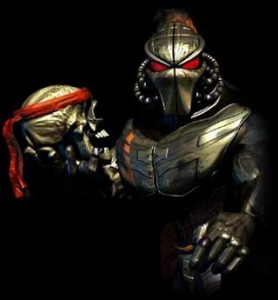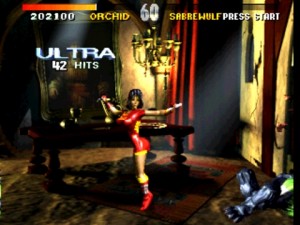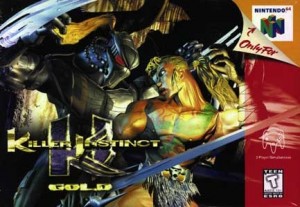K is for Killer Instinct
by Sindra, filed in Games, Powet Alphabet on Sep.12, 2009
 Since the alphabet is the building block of our language, the Powet Alphabet is the building block of what makes us geeks.
Since the alphabet is the building block of our language, the Powet Alphabet is the building block of what makes us geeks.
Back in the gaming days of yore, the multiple genres of video games defined what type of gamer the person playing would be. You had your RPG gamers, your FPS gamers, your sidescrolling-adventure gamers, and your sports gamers, to name a few. (Though the sports gamers are considered a completely separate category from the rest and its fans are often rejected as being gamers at all. You know what I’m talking about) There was also the highly competitive fighting gamer. Despite one-on-one fighting games existing prior to its release, Mortal Kombat and Street Fighter helped shape the genre into a more standardized style and gained it a following. It also found a niche in the arcade scene, and soon arcades across the nation were featuring fighting games left and right. However, MK and SF couldn’t carry the genre alone. Games like Primal Rage and NightWarriors soon popped up to satisfy the masses. Midway saw the goldmine that Mortal Kombat had brought in, and decided to try another fighting game in order to bank on the growing success. This game was Killer Instinct.
 Developed by Rare in 1994 and produced by both Midway and Nintendo, Killer Instinct was released in the arcades first, and then enjoyed a high-profile release on the Super Nintendo shortly after. A port for the Gameboy was also created. Killer Instinct took aspects of the two kings of the fighting games, Mortal Kombat and Street Fighter, and absorbed them into its own style. It then took a unique approach with several other aspects, including a double-life bar that could carry over during matches, and automatic combos that could be used in tandem with the MK-esque “No Mercy” finishers.
Developed by Rare in 1994 and produced by both Midway and Nintendo, Killer Instinct was released in the arcades first, and then enjoyed a high-profile release on the Super Nintendo shortly after. A port for the Gameboy was also created. Killer Instinct took aspects of the two kings of the fighting games, Mortal Kombat and Street Fighter, and absorbed them into its own style. It then took a unique approach with several other aspects, including a double-life bar that could carry over during matches, and automatic combos that could be used in tandem with the MK-esque “No Mercy” finishers.
The story of the game was never terribly in-depth, as was the norm for most fighting games. Why worry about a story when you’re in it just to kick another person’s ass? Regardless, KI is set in the future where mega-corporations dominate the economy and government of the nation, basically allowing them to get away with pretty much anything. Ultratech is one such mega-corporation, which develops highly-advanced cybernetic technology and experimental genetic weaponry. Ultratech creates the tournament known as “Killer Instinct” in order to test their creations against highly-skilled combatants who enter for whatever reasons of their own. (The motives of many characters for entering are hazy at best and non-existent for the most part) Ultratech will then use their superior technology to open gates to other dimensions, eventually leading to the release of the two-headed monstrosity known as Gargos from his extra-dimensional prison, who serves as a boss.
Like was mentioned before, Killer Instinct was one of the first games to introduce chain-combos into fighting games. In fact, KI became famous due to the fact that its combo-rates were insane and could result in high-number chains. This was due in part to the automatic combos that could be executed by a pre-determined set of button-pushes or special move, rather than pushing individual buttons for individual attacks in a string. A set of two auto-combo moves could result in a 20-hit combo rather than a 6-hit. Ultra-combos, often used as a finisher along with the No Mercy, could get as high as 80-hits. The introduction of these auto-combos gave players the challenge of seeing how high they could get their combo-string up to. This also required the introduction of combo-breaker moves, in order to balance gameplay and give the victim a chance rather than having a psychotic combo finish them before they could land a punch. Bonus material for the SNES release featured an arranged soundtrack to the game called “Killer Cuts” bundled in as well.
button-pushes or special move, rather than pushing individual buttons for individual attacks in a string. A set of two auto-combo moves could result in a 20-hit combo rather than a 6-hit. Ultra-combos, often used as a finisher along with the No Mercy, could get as high as 80-hits. The introduction of these auto-combos gave players the challenge of seeing how high they could get their combo-string up to. This also required the introduction of combo-breaker moves, in order to balance gameplay and give the victim a chance rather than having a psychotic combo finish them before they could land a punch. Bonus material for the SNES release featured an arranged soundtrack to the game called “Killer Cuts” bundled in as well.
Due to its surprising popularity in arcades and on the SNES, a sequel was released in 1996. Killer Instinct 2 picked up where the last game left off. The true end-boss of the first game, known as Eyedol, was defeated at the hands of the fighter Black Orchid. His destruction created a time-warp, which sucked in the remaining fighters, and threw them 2,000 years into the past, and resulting in the initial release of Gargos from limbo. The surviving fighters track down Gargos in an attempt to find a way home, or to outright defeat him and ensure the timeline is not disrupted.
Killer Instinct 2 still retained the majority of systems seen in the first game. Auto-combos are still a staple, and a throw move in introduced to deal with blocking. Special moves no longer are judged on priority, but instead follow a three tiered system, in which a certain special move will always break another certain special move. A super bar is also thrown in, much like the one in Street Fighter Alpha, and when full allows for multi-hit Super Moves.
 Killer Instinct and Killer Instinct 2 were never released on the Nintendo 64, despite previous allegations that it would be. This resulted in the release of Killer Instinct Gold, which was developed solely for the N64 system. Gold was based on KI2, but due to small memory capabilities, replaced flipbook background with low-grade rendered polygon based ones. What it did offer were Team Battles and unlockable content. Dependant on who you were, it was either a fair or a lousy trade-off.
Killer Instinct and Killer Instinct 2 were never released on the Nintendo 64, despite previous allegations that it would be. This resulted in the release of Killer Instinct Gold, which was developed solely for the N64 system. Gold was based on KI2, but due to small memory capabilities, replaced flipbook background with low-grade rendered polygon based ones. What it did offer were Team Battles and unlockable content. Dependant on who you were, it was either a fair or a lousy trade-off.
After Gold was released, Killer Instinct fell off the face of the gaming map. No other sequels were produced, despite fan request and its success in the arcades. Rumors of a Killer Instinct 3 game have been few and unsubstantiated, and it would seem the series has run its course. This could be considered a mixed blessing, given that fighting games with multiple sequels can often become stale or knocked off-course, much like recent games. Still, with a good amount of nostalgia-steam fueling it, Killer Instinct could very well return to become a contender again, if production was placed in the right hands.


 PS3
PS3
 Famicom Dojo
Famicom Dojo KEEP PLAYING
KEEP PLAYING KEEP PLAYING: Rewind
KEEP PLAYING: Rewind Powet Toys
Powet Toys Powetcast
Powetcast Hitchhiker's Guide POWETcast
Hitchhiker's Guide POWETcast














